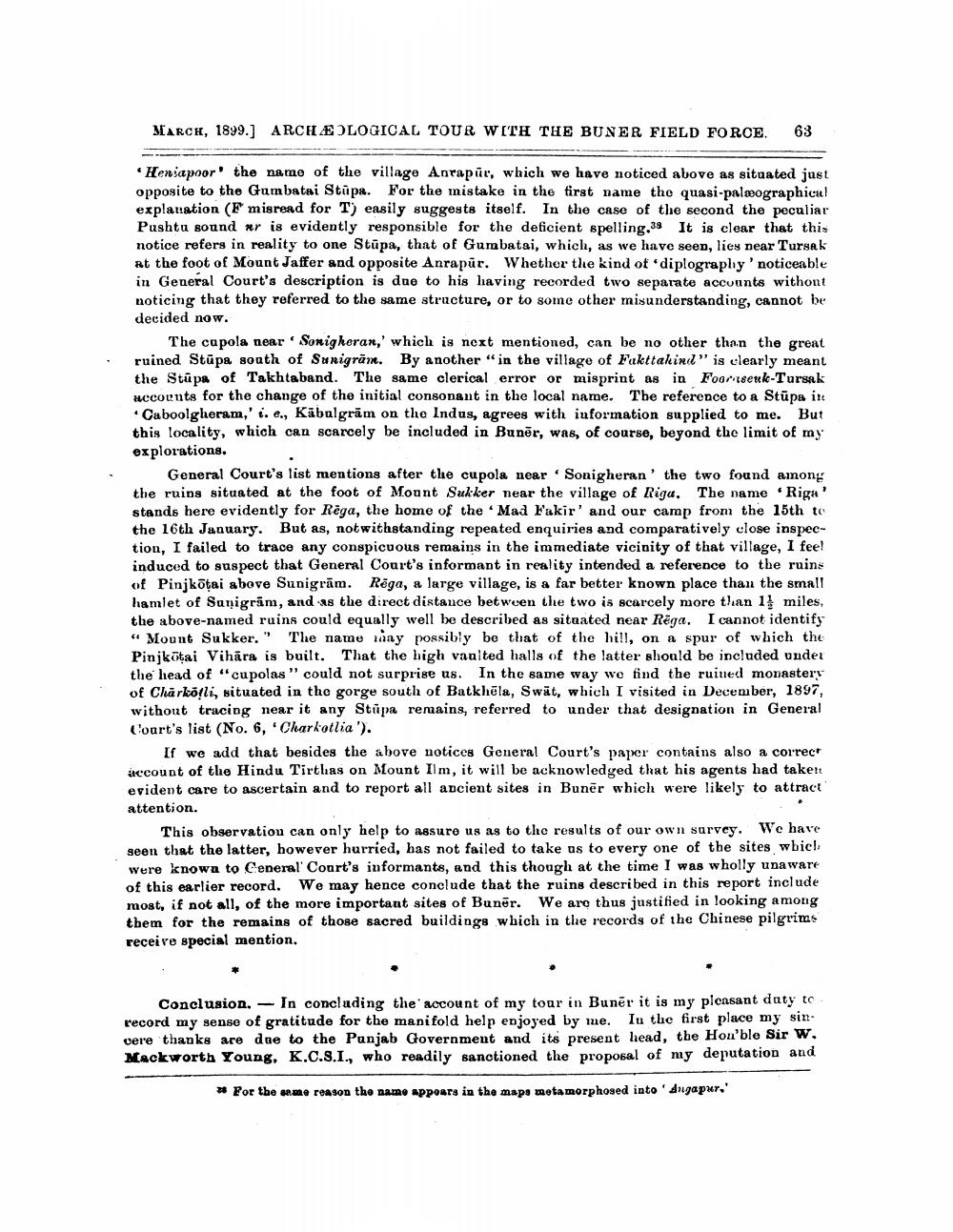________________
MARCH, 1899.) ARCHÆOLOGICAL TOUR WITH THE BUNER FIELD FORCE
63
Heniapoor the name of the village Anrapür, which we have noticed above as situated just opposite to the Gumbatai Stūpa. For the mistake in the first name the quasi-palæographical explanation (F misread for T) easily suggests itself. In the case of the second the peculiar Pushtu sound ar is evidently responsible for the deficient spelling,38 It is clear that this notice refers in reality to one Stupa, that of Gumbatai, which, as we have seen, lies near Tursak at the foot of Mount Jaffer and opposite Anrapür. Whether the kind of diplography 'noticeable in General Court's description is due to his having recorded two separate accounts withont noticing that they referred to the same structure, or to some other misunderstanding, cannot be decided now.
The capola near Sonigheran,' which is next mentioned, can be no other than the great ruined Stūpa south of Sunigrān. By another "in the village of Fukttakirıl" is clearly meant the Stupa of Takhtaband. The same clerical error or misprint as in Foomsetek-Tursak accounts for the change of the initial consonant in the local name. The reference to a Stūpa itt • Caboolgheram,' . e., Kābulgrām on the Indus, agrees with information supplied to me. But this locality, which can scarcely be included in Bunēr, was, of course, beyond the limit of my explorations.
General Court's list mentions after the cupola near Sonigheran' the two found among the ruins situated at the foot of Mount Sukker near the village of Riga. The name Riga' stands here evidently for Rega, the home of the 'Mad Fakir' and our camp from the 15th to the 16th January. But as, notwithstanding repeated enquiries and comparatively close inspection, I failed to trace any conspicuous remains in the immediate vicinity of that village, I feel induced to suspect that General Court's informant in reality intended a reference to the ruins of Pinjkotai above Sunigrām. Rēga, a large village, is a far better known place than the small hamlet of Sanigram, and as the direct distauce between the two is scarcely more than 15 miles, the above-named ruins could equally well be described as situated near Rēga. I cannot identify “ Mount Sukker." The name inay possibly be that of the hill, on a spur of which the Pinjkötai Vihāra is built. That the high vanited halls of the latter should be included under the lead of "cupolas" could not surprise us. In the same way we find the ruined monastery of Chårkolli, situated in the gorge south of Batkhēla, Swat, which I visited in December, 1897, without tracing near it any Stupa remains, referred to under that designation in General Court's list (No. 6, 'Charkotlia').
If we add that besides the above notices General Court's paper contains also a correct account of the Hindu Tirthas on Mount Ilm, it will be acknowledged that his agents had takert evident care to ascertain and to report all ancient sites in Buner which were likely to attract attention.
This observation can only help to assure us as to the results of our own survey. We have seen that the latter, however hurried, has not failed to take as to every one of the sites which were known to Ceneral Court's informants, and this though at the time I was wholly unaware of this earlier record. We may hence conclude that the ruins described in this report include most, if not all, of the more important sites of Bunēr. We are thus justified in looking among them for the remains of those sacred buildings which in the records of the Chinese pilgrims receive special mention.
Conclusion. In concluding the account of my tour in Bunēr it is my pleasant daty to record my sense of gratitude for the manifold help enjoyed by me. In the first place my sincere thanks are due to the Punjab Government and its present head, the Hon'ble Sir W. Mackworth Young, K.C.S.I., who readily sanctioned the proposal of my deputation and
* For the same reason tho namo appears in the maps metamorphosed into 'Angapur.




